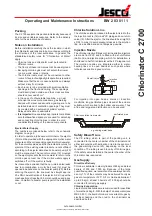
Chlorinator C 2700
BW 2 03 01 / 5
Operating and Maintenance Instructions
Operating the System
Before startup, check once again if the number of chlorine
tanks connected is sufficient for the chlorine consumption.
Then the flow meter can be fully opened. Rule of thumb:
Maximally 1 % of the filling weight of a chlorine tank may
be delivered as gas per hour. If an evaporator is used for
gas supply, it must be preliminarily heated for operation.
In this case, 20 % of the liquid chlorine contents may be
taken from the tank per hour.
Startup
For startup, first open the main and auxiliary valves (2) of
the chlorine tanks and then the shutoff valve (16) (injection
nozzle) and motive water line. Under perfect operating
conditions, a vacuum is produced in the ejector, which is
propagated via the ejector non-return valve (13), the ball
cock (12) and the suction line to the chlorinator and
causes the chlorine gas inlet valve to open. Chlorine gas
starts to flow and is mixed with motive water in the ejector.
The exact chlorine gas quantitiy required can be set at
the adjusting screw. The chlorine quantity is read at the
top edge of the float.
Switching Off the System
The cylinder/barrel connecting valves (2) are closed. To
switch off the system the float must be on zero level (and
the system must not contain chlorine gas under excessive
pressure anymore).
Caution!
Before longer periods of standstill, the lines and devices
carrying gas must be flushed with nitrogen for about
5 minutes. All dismounted devices, lines and fittings in
contact with chlorine must be cleaned and dried and
protected against humid air by inserting plugs. Empty the
water-carrying parts if there is danger of frost.
Maintenance
Regular maintenance avoids problems. We recommend
a maintenance contract.
If there are no rules/specifications (e.g. GUV 8.15) or
special annotations prescribing shorter maintenance
intervals, all JESCO chlorinators have to be maintained
and tested by an authorized specialist firm at least once
a year. Preferably this should happen at the beginning
of a high-rate period, prior to a downtime or a restart.
General
The vacuum systems described need little maintenance.
Nevertheless, a chlorination installation must not be
without observation. Even the smallest leak is growing
larger within a short time due to the aggressiveness of
humid chlorine gas and causes other parts to corrode.
Therefore stop the installation immediately if a leak is
detected and eliminate the error.
Working on the gas pressure line, replacing the
cylinder/barrel
If a defective part has been detected, close the chlorine
cylinder/barrel valves and suck off the gas by switching
on the system. Dismount the defective part and protect
the remaining gas line against humiditiy (e.g. put a dry
cloth into the pipe end).
HUMIDITY IN THE PIPING CAUSES LOCALIZED
CORROSION!
Close main valve tightly before exchanging the chlorine
cylinder/barrel and disconnect it from the main valve
using a fork wrench. Mount the protective cap of the
chlorine cylinder/barrel. Do not bend the flexible copper
line when dismounting it. Position full barrel on the
support and remove protective cap. For further
information, see item 1.8.
Provide the auxiliary valve with a new sealing and open
the main valve shortly. Check with ammonia whether the
connection is gastight. For recommissioning, make sure
that the new cylinder/barrel has room temperature. and
never exceeds it.
Cleaning the installation
Before
working on the chlorination installation, it is
absolutely necessary to close the chlorine cylinder/
barrel valves and suck off the chlorine gas until the flow
meter and chlorine pressure gauge show zero.
Disassembling the flow meter
Carefully remove the limiting plugs of the measuring
glasses (observe float) and clean them with water only.
The floats must not be damaged. Clean the glasses and
floats with water or isopropyl alcohol. Dry parts completely!
When assembling the flow meter, the upper and lower
seals must be concentric.
Lutz-Jesco GmbH
Improved changes are always reserved without notice.







